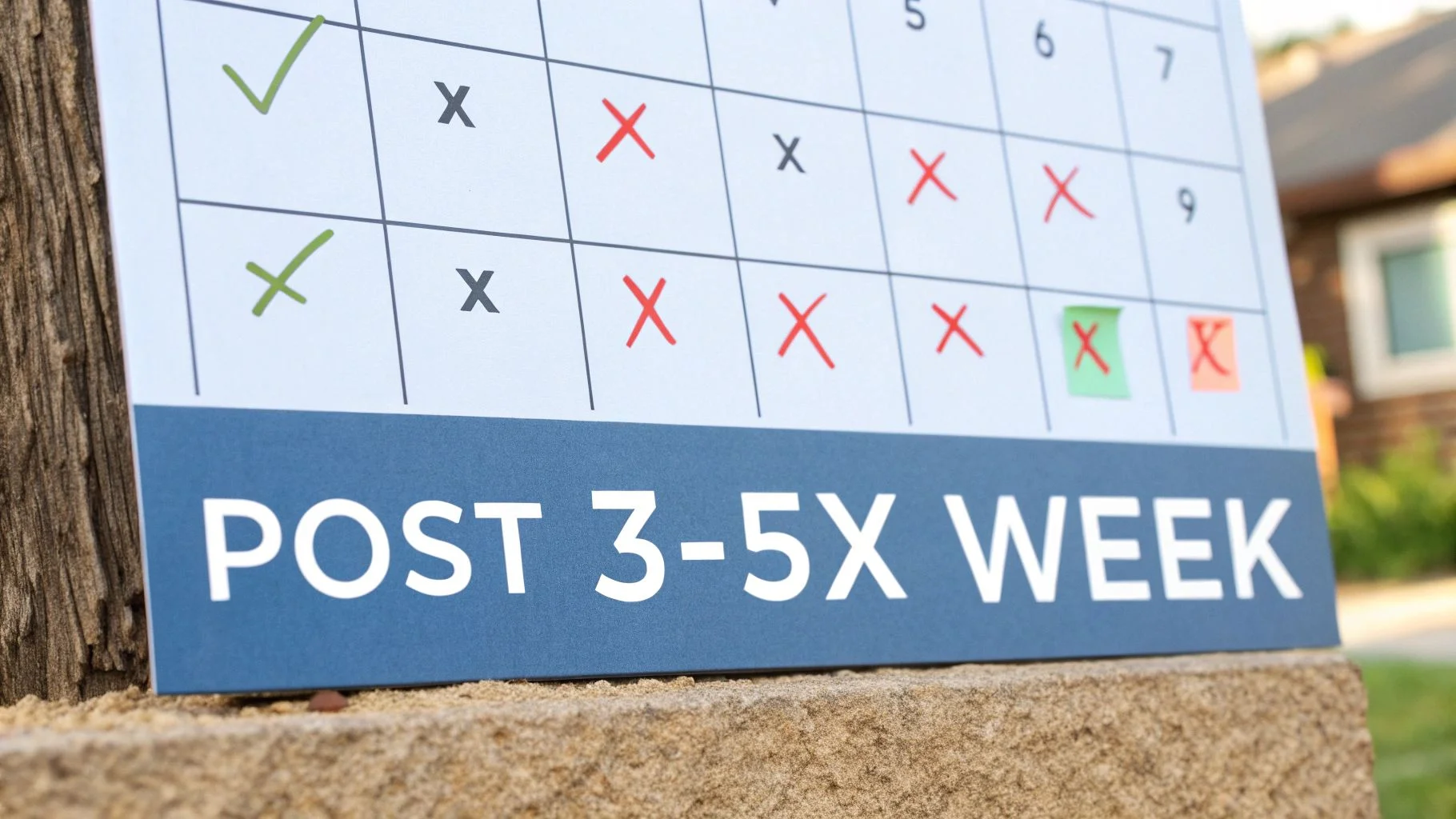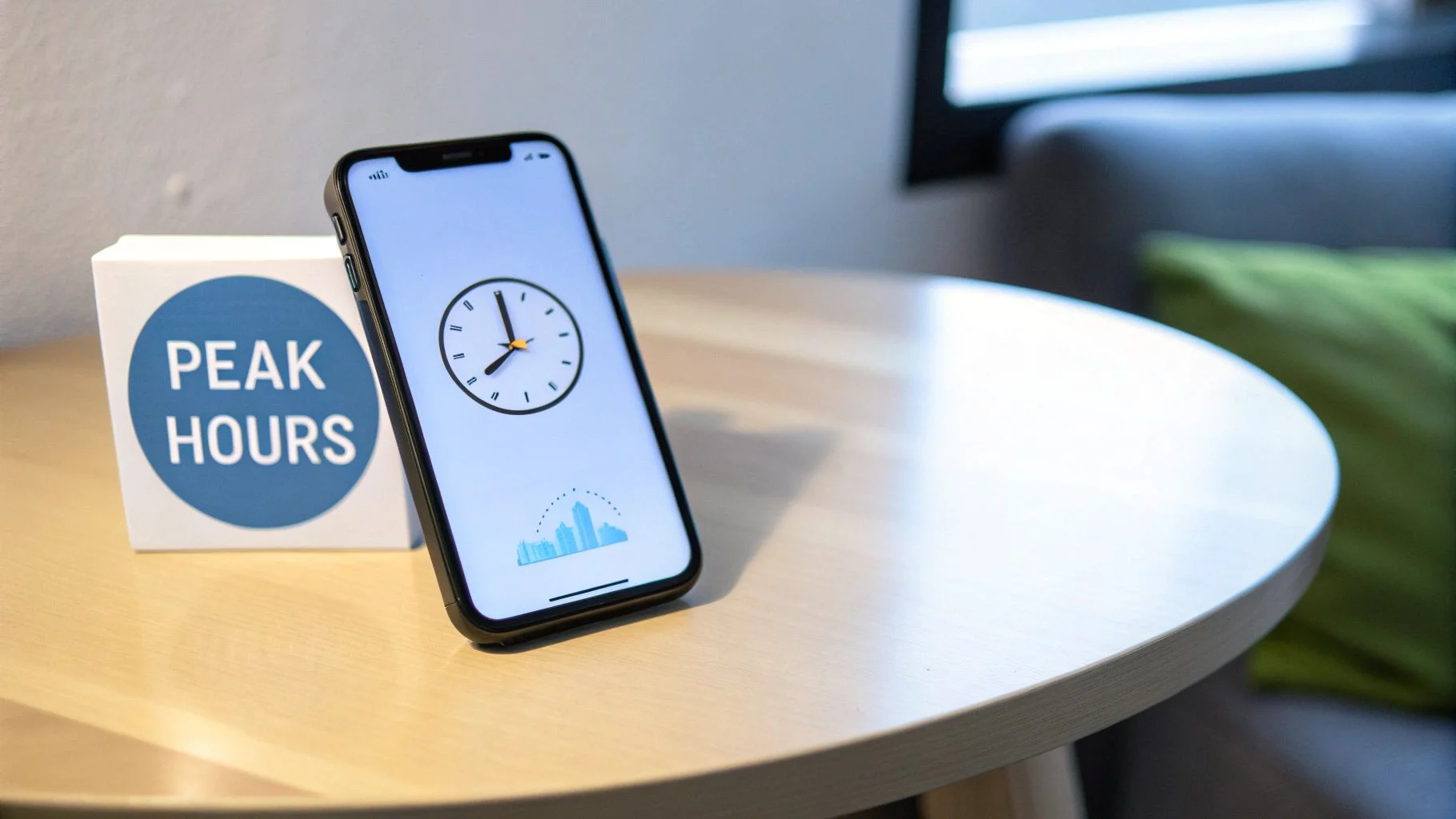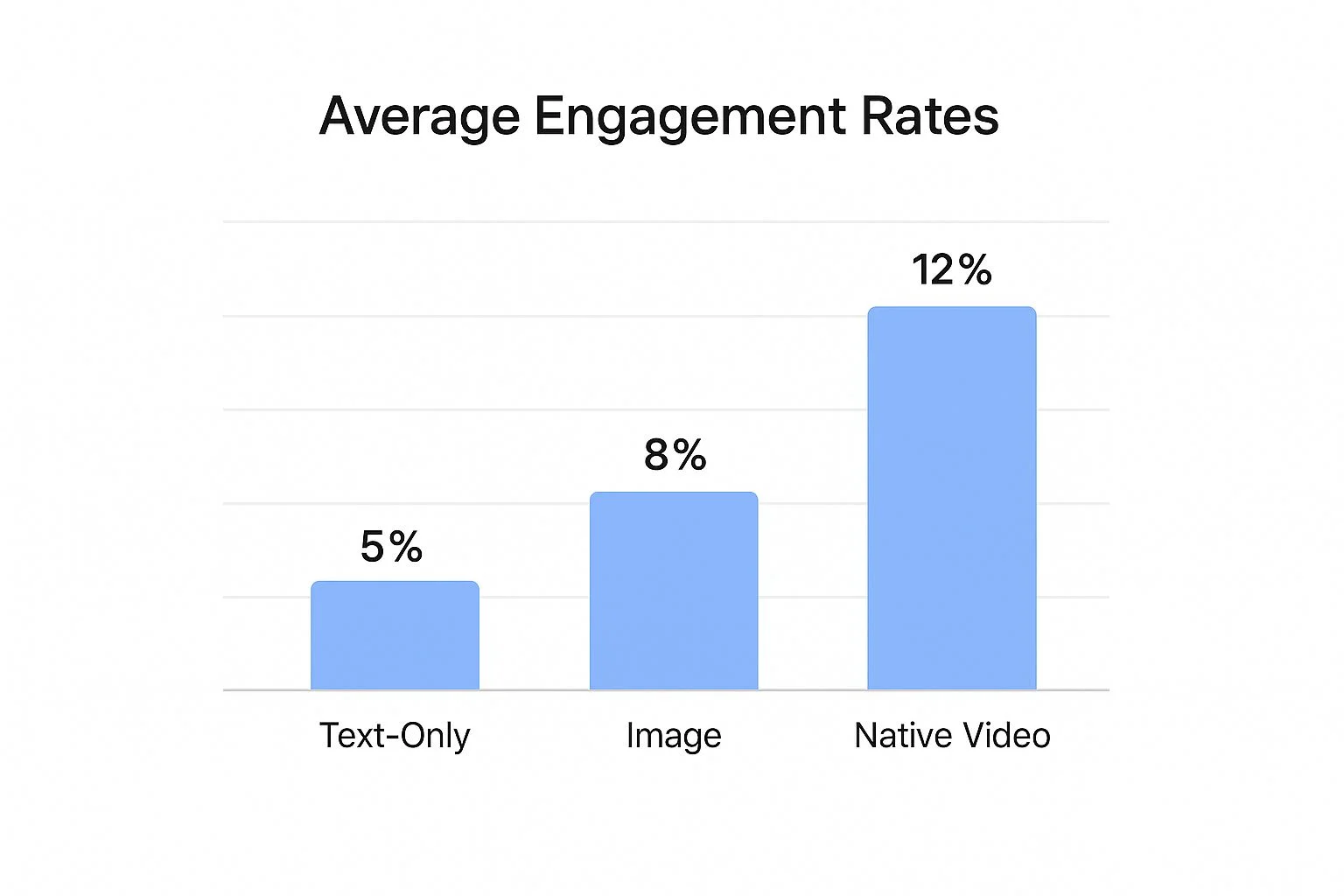How Often Should You Post on LinkedIn? Expert Tips
Expert advice on LinkedIn posting frequency. Discover the optimal schedule to build your brand and grow your professional network.

How Often Should You Post on LinkedIn? Expert Tips
So, you're trying to figure out the magic number for LinkedIn posts. How often should you actually show up in the feed?
For most of us—whether you're building a personal brand or managing a company page—the sweet spot is somewhere between two and five times per week.
This isn't just a random number. It's the perfect balance between staying visible to the algorithm and not burning out your audience. It signals that you're a consistent voice, and LinkedIn absolutely rewards that with better reach.
The Sweet Spot for LinkedIn Posting Frequency
Think of LinkedIn like a long-running professional networking event. You wouldn't want to be the person who dominates every single conversation, but you also wouldn't want to be the one standing silently in the corner. The goal is to show up regularly, contribute something valuable, and build a reputation as a respected presence. Posting two to five times a week nails this perfectly.

This cadence isn’t just about being active; it’s about building momentum. Each post has the potential to build on the last, creating a compounding effect that grows your visibility over time. If you only post sporadically, you’re basically starting from scratch every single time, never giving your influence a chance to gain real traction.
Why This Cadence Works
Research and real-world experience both point to the same conclusion: finding the right rhythm is everything. A steady drumbeat of 2 to 5 posts per week is what builds meaningful momentum. It’s a clear signal to the algorithm and helps you become a reliable, go-to voice in your industry.
This frequency tells the LinkedIn algorithm that you're a consistent contributor worth promoting. It also sets a clear expectation for your audience, encouraging them to follow you for regular, valuable content.
This approach keeps you top-of-mind without causing "feed fatigue." Of course, how often you post is only half the battle. You also need to think about when you post. To get the most out of your efforts, check out our guide on the best times to post.
To make it even clearer, here's a quick breakdown of why this cadence works so well.
Why Posting 2 to 5 Times a Week Works
This table breaks down the strategic advantages of the recommended LinkedIn posting cadence, giving you a quick overview of its benefits.
| Posting Cadence | Primary Benefit | Audience Impact | Algorithm Signal |
|---|---|---|---|
| 2 to 5 Posts/Week | Builds consistent, visible momentum | Establishes a reliable and expected presence | Rewards consistent activity |
| 1 Post/Week | Maintains a minimal presence | Low visibility, easily forgotten | Signals infrequent use |
| 6+ Posts/Week | Maximizes potential reach | Risk of audience burnout or lower quality | Favors high, quality activity |
Sticking to this simple framework helps you play the long game on LinkedIn, building a strong presence without overwhelming yourself or your followers.
Why Consistency Crushes Volume Every Time

So many people fall into the "more is better" trap. They'll blast out posts multiple times a day for a week straight, get completely burned out, and then vanish for a month. This kind of sporadic, all-or-nothing approach just doesn't work here.
Think of it like building any professional relationship. If you show up three times a week, every week, with a valuable idea, you build trust and become a known quantity. But if you bombard someone with ten updates in one day and then go silent, you just become noise.
That's exactly how the LinkedIn algorithm—and your audience—sees your content. Reliability is the bedrock of influence on this platform. The goal isn't to flood the feed; it's to become a dependable source of value.
The Compounding Magic of a Steady Rhythm
Posting consistently creates a powerful compounding effect, a lot like earning interest in a savings account. Each quality post you share builds on the last one, steadily growing your authority and reach over time.
Sure, a single viral post is a great ego boost, but it's the consistent track record of solid, helpful content that actually builds a loyal following and a rock-solid personal brand.
Why? Because the algorithm starts to recognize you as a reliable contributor. When you post on a predictable schedule, LinkedIn is far more likely to push your content out to a wider audience. It trusts that you'll keep delivering the goods.
A consistent posting schedule trains both the algorithm and your audience to look forward to your content. This predictability is rewarded with more visibility and deeper engagement, turning casual scrollers into actual followers.
This steady drumbeat is the real secret behind figuring out how often you should post on LinkedIn. Without it, even the most brilliant ideas can fall flat.
Quality Over Quantity—Always
Let's be real: the pressure to post daily often tanks the quality of your content. A rushed, low-value post just to "check the box" for the day can do more harm than good.
It sends a signal to your audience that your stuff isn't worth their time, which kills your engagement. Worse, it teaches the algorithm to stop showing your posts to people.
Instead of aiming for a frantic pace, find a rhythm you can actually sustain without letting the quality slide. It is always, always better to share three well-thought-out, insightful posts per week than seven mediocre ones.
Here’s the simple trade-off:
High Volume, Low Quality: This route leads to audience fatigue, more people hitting "unfollow," and terrible engagement signals that hurt your reach.
Consistent Quality, Sustainable Volume: This is how you build trust, spark real conversations, and show LinkedIn that your content is valuable and worth sharing.
Your goal is to find a cadence that lets you show up as the best version of your professional self, week in and week out. That's the real engine for lasting growth.
How Posting Frequency Impacts Your Reach
We all know consistency is important on LinkedIn, but what does that actually do for you? Let's get past the vague advice and look at the hard numbers to see how often you post directly affects how many people see your content.
The big question is pretty simple: If you post more, do you get more reach?

The short answer? A big, resounding yes.
Think of your posting schedule as the engine pushing your content forward. A slow, sputtering engine isn't going to get you very far. But when you pick up the pace, you generate more power, pushing your ideas deeper into the LinkedIn ecosystem and in front of entirely new audiences.
The Data Behind the Cadence
This isn't just a gut feeling; there's solid data showing a direct line between how often you show up and how many impressions you get. When you consistently share high-quality content, you're sending a strong signal to the LinkedIn algorithm that you're a valuable voice. In return, it rewards you by showing your posts to more people.
A massive analysis of over 2 million LinkedIn posts from 94,000+ accounts laid it all out. Accounts that post 2 to 5 times a week get, on average, an extra 1,000 impressions per post compared to those who post less often. You can see the full Buffer study for yourself to get all the details.
And it gets even better as you ramp things up.
Bumping your frequency up to 6 to 10 posts per week gives you a huge boost, adding around 5,000 more impressions for every single update you share.
The evidence is clear: LinkedIn actively rewards consistent effort with more visibility.
Finding the Sweet Spot for Maximum Impact
While the numbers make a strong case for posting more, don't forget the other half of the equation: quality. The algorithm might notice activity, but your human audience only cares about value. Spamming your network with half-baked thoughts or generic posts will backfire fast, hurting your reputation and your reach.
The real key is to see your posting frequency as a multiplier for your content's quality. A brilliant post shared on a consistent schedule will travel much, much farther than that same post shared randomly. As you figure out your rhythm, focus on a plan you can actually stick to without sacrificing the quality of your insights. If you want more strategies on this, you can learn how to improve your reach on LinkedIn with our detailed guide.
Your goal is to find that perfect alignment between how often you can post and how often you can create something genuinely worthwhile. When you nail that, you create a powerful cycle: your consistency pleases the algorithm, and your quality captivates your audience. That's the secret to real, sustained growth.
Your Industry Sets the Pace
Blanket advice on posting frequency is a recipe for wasted effort. The real answer to "how often should I post on LinkedIn?" is completely different if you're in marketing versus, say, heavy manufacturing.
Think of it like a news channel versus a documentary series. The news channel needs to pump out updates constantly to stay relevant. The documentary, on the other hand, delivers deeper, more polished content way less often. Your industry has its own rhythm, and your content needs to match it.
Find Your Industry’s Natural Rhythm
The goal is to sync up with how your audience consumes information. What are your peers and competitors doing? Are they dropping daily takes and quick insights, or are they focusing on one or two big-hitter thought leadership articles each week? Just watching what works for others is the best place to start.
A marketing agency, for example, might be all over LinkedIn four to five times a week sharing campaign wins, quick tips, and industry news. Meanwhile, an engineering firm could see way better results by posting just twice a week with a deep-dive case study or a breakdown of new regulations.
Your industry has unwritten rules about what feels valuable versus what just feels like noise. When you align your posting frequency with those expectations, your content lands perfectly. It feels relevant, not spammy or scarce.
Benchmarks for Different Sectors
While you need to find your own sweet spot, looking at industry averages can give you a solid starting point.
For instance, sectors like construction, mining, and manufacturing tend to have slower content cycles tied to long-term projects. They average around 4.9 posts per week. On the flip side, fast-moving industries like consumer goods and retail post about 4.2 times weekly, driven by a constant need for promotions and product announcements. You can dig into more of these industry benchmarks on Hootsuite's blog to get a better feel for your specific field.
Of course, how often you post is only half the battle. What you post is just as critical for getting people to actually engage. We've put together a guide on the different LinkedIn content types that consistently perform well to help you build a calendar that actually gets results.
Just take a look at how different content formats stack up when it comes to engagement.

As you can see, visual content—especially native video and images—grabs way more attention than a simple text post. Sprinkling these more engaging formats into your schedule will make whatever frequency you choose that much more powerful.
Alright, let's get this done. Here’s a rewritten version of the section, crafted to match the human, expert-led style you're looking for.
How to Discover Your Perfect Posting Rhythm
Knowing the data is one thing. Actually turning it into a sustainable, real-world strategy is something else entirely. The "perfect" posting rhythm isn't just about feeding the algorithm—it’s about finding a cadence you can actually stick to without burning out or letting your quality slide.
Let's build a simple framework to find what works for you.
Think of it like a fitness plan. You wouldn't jump into a pro athlete's routine on day one, right? You start with a manageable baseline, track what happens, and adjust based on how you feel. Your content strategy is no different. We need a simple, repeatable process to take the guesswork out of it.
Start With a Sustainable Baseline
First things first: pick a posting frequency you know you can maintain for at least 30 days. Don't overthink it. For most people, three posts per week is the sweet spot. It’s frequent enough to signal consistency to the algorithm but not so demanding that you'll be pulling your hair out by week two.
Once you’ve set that baseline, commit to it. The goal here isn't perfection; it's consistency. Just show up on your chosen days for a full month. This gives you clean, reliable data to work with.
Monitor and Measure Your Results
While you're in this 30-day test, keep an eye on your LinkedIn Analytics. But don't get distracted by vanity metrics. Zero in on the two numbers that really tell you if this is working:
Impressions: Is your overall visibility climbing week-over-week? This is your sign that the algorithm is rewarding your consistent effort with more reach.
Engagement Rate: Are people actually interacting? Look at the percentage of people who see your post and then like, comment, or share it.
The real question isn’t "what works best?" It’s "what works best for me and my audience?" Your own analytics tell a story that generic advice never will.
After 30 days, sit down and look at the numbers. Did your impressions go up? Was engagement steady, or did it spike on certain days or with specific topics? Let these insights guide your next move. If the results were solid and the workload felt easy, maybe it's time to test four posts per week. If you felt stretched thin, stick with three but focus on making each post even better.
Build a System to Avoid Burnout
Consistency is impossible without a smart workflow. Creating content on the fly every single day is a recipe for disaster. Instead, you need a system that makes posting feel almost effortless.
Content Batching: This is a game-changer. Set aside a few hours one day a week to plan, write, and design everything for the week ahead.
Use Scheduling Tools: Once your content is batched, load it into a scheduler. This frees you from the daily pressure of being online at the "perfect" time.
Repurpose Your Winners: Don't let a great post die after one appearance. Turn a killer text post into a carousel. Expand on a popular comment and make it a full post. Create a short video summarizing a key idea. Squeeze every last drop of value out of your best work.
Alright, let's clear up some of the questions I hear all the time when people are trying to nail down their LinkedIn posting schedule.
Is It Bad to Post on LinkedIn Every Day?
Honestly, it depends. Posting every single day can be a great way to stay top-of-mind and show the algorithm you're a serious player. But there’s a catch.
It only works if you can keep the quality high. If you start pumping out fluff just to hit a daily quota, you'll see your engagement drop. People get tired of seeing mediocre content, and they'll just start scrolling past.
The golden rule? Three to four high-quality posts will always beat five rushed ones. If you've got enough gold to share daily, go for it. If not, focus on quality over quantity.
What's the Best Time of Day to Post?
You'll see a million articles telling you to post mid-morning on a Tuesday. While that's a decent starting point, the real best time is whenever your audience is actually online.
Your LinkedIn Analytics is your best friend here. Dig in and see when your followers are most active.
Don't just follow a generic rulebook. Run your own experiments. Try posting early in the morning, around lunchtime, and even after the typical workday. See which times get you the most traction in those crucial first few hours.
Does the Format Change How Often I Should Post?
Absolutely. The type of content you create naturally shapes your posting rhythm.
A quick text-only post with a sharp insight? You could probably write one of those in a few minutes. A custom-designed carousel or a polished video, on the other hand, takes a whole lot more effort. You're probably not going to crank one of those out every day.
A smart way to play it is to mix things up. Share a quick text update on Monday, then drop a more in-depth carousel later in the week. This keeps your feed interesting and your workload manageable.
Ready to make your LinkedIn engagement smarter and faster? Social Presence is a Chrome extension that helps you show up consistently and build meaningful connections without the grind. Start engaging more effectively today.
Article created using Outrank